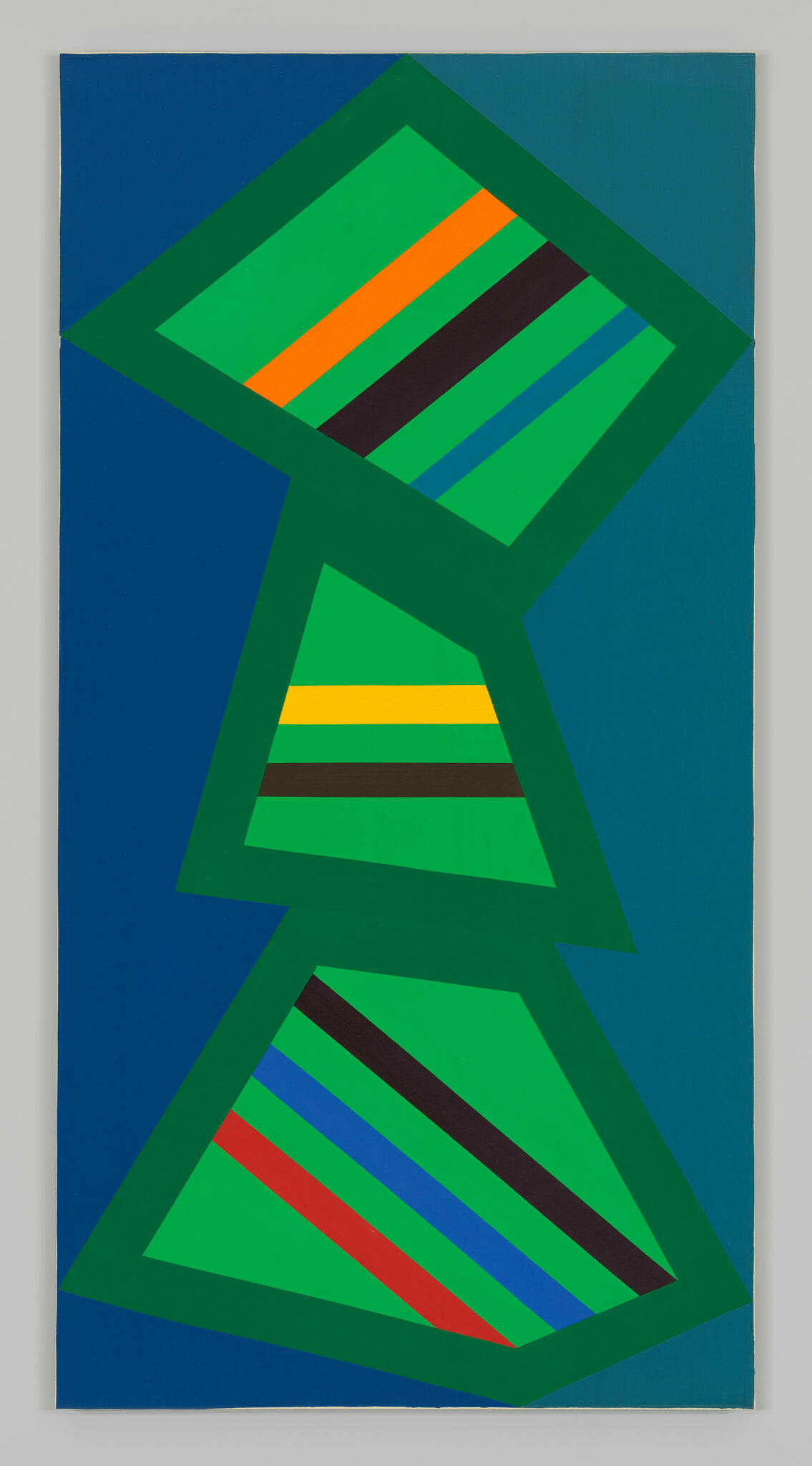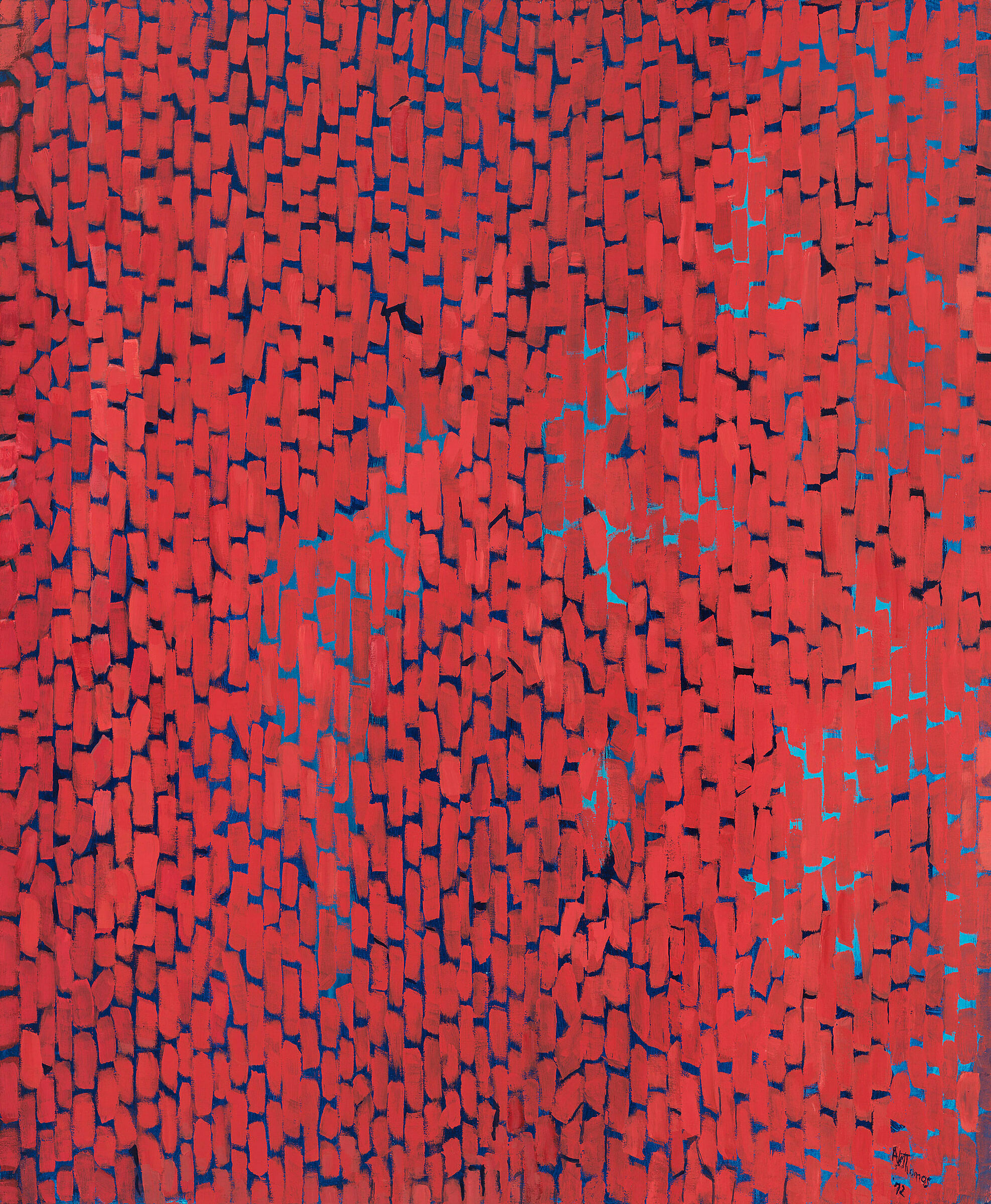Not on view
Date
1974
Classification
Paintings
Medium
Acrylic on canvas
Dimensions
Overall: 70 1/8 × 35 7/8in. (178.1 × 91.1 cm)
Accession number
2021.20
Credit line
Whitney Museum of American Art, New York; purchase, with funds from the Painting and Sculpture Committee
Rights and reproductions
© Freddy Rodríguez
Visual description
Freddy Rodriguez,Y me quedé sin nombre, 1974.Y me quedé sin nombre(translated to "and I remained without a name") is a highly geometric acrylic painting on canvas. The painting measures 70 ⅛ inches tall by 35 ⅞ inches wide.
Three dark green outlines of shapes—a parallelogram, a trapezoid, an outstretched kite—balance atop each other. Inside of the parallelogram, the trapezoid, and outstretched kite are straight lines crossing the lime green filling of each shape. The parallelogram features an orange line, a brown line of equal thickness, and a thinner desaturated blue line–all running diagonally to the left. In the middle, the trapezoid features two lines—one thicker yellow line and one thinner brown line—running parallel to the base of the painting. The third and final form—the outstretched diamond shape—has a red line, a blue line, and a brown line (all of equal thickness) extending diagonally to the right. The blue background of the painting—darker on the left side and lighter on the right—is both flat and dynamic, playing into the illusion of shadows and depth.
The artist chose to include vibrant green hues, which we might associate with spring, birth, and vitality. The geometric elements might evoke a traffic stop light that has every bulb glowinggreen go go.
Rodríguez’s attention to balance, shape, proportion, and scale all work to create an abstract painting that references the human body in motion with influences from dance and movement of Merengue and Bachata, two dances made popular inthe Dominican Republic, Rodríguez’s birthplace.
Conceptually, the name of the paintingY me quedé sin nombre(which translates to "and I remained without a name") points to another abstraction. Instead of simply titling this work “Untitled” or “sin título,” Rodríguez chose a less detached, more poetic way of saying the same thing. In doing so, he might be imbuing a potentially impersonal abstraction with subjective sensibilities, subverting any notion of objectivity.
Audio
-
Freddy Rodríguez, Y me quedé sin nombre, 1974
In In the Balance: Between Painting and Sculpture, 1965–1985
0:00
Freddy Rodríguez, Y me quedé sin nombre, 1974
0:00
Narrator: Marcela Guerrero is an Associate Curator at the Museum.
Marcela Guerrero: When I see this painting, I see this sole figure dancing. When you’re dancing Merengue, Salsa, or Bachata, it wouldn't be uncommon for your head and your torso and your legs to be in three different points or moving in three different directions.
The box and kind of the hard angles of these three sections that you see in the painting can also relate to dance in the sense that when you're dancing, you want to create a frame with your arms. You have a certain path that you move. You have some flexibility within that, but that's kind of the fundamentals of many dance forms.
And then the lines embedded in each of these three blocks for me, they point to musical notes.
Narrator: When a teacher of Rodríguez’s gave him a pass to the the Museum of Modern Art, shortly after arriving in New York in the late 1960s, he was struck by Piet Mondrian’s geometric painting Broadway Boogie Woogie. Abstraction opened up a world of possibilities for Rodríguez.
Marcela Guerrero: For him it was kind of a way of saying, or thinking, you know, “I can do abstraction, I can do something that grounds me, that takes me away from the chaos that's in my life and from where I came from.”
The title is Y me quedé sin nombre, which translates to “and I remained unnamed,” or “I ran out of names.” I think it points to a sort of abstraction. It's kind of another way of saying “untitled” without that detachment or without sounding so cold.
-
Freddy Rodríguez, Y me quedé sin nombre, 1974
In In the Balance: Between Painting and Sculpture, 1965–1985 (Spanish)
0:00
Freddy Rodríguez, Y me quedé sin nombre, 1974
0:00
Narrator: Marcela Guerrero es curadora asociada en el museo.
Marcela Guerrero: Cuando veo esta pintura, veo una única figura bailando. Y cuando estás bailando, es habitual que la cabeza, el torso y las piernas estén en tres lugares diferentes o se estén moviendo en distintas direcciones.
La caja y los ángulos rectos de estas tres secciones que se ven en la pintura también pueden relacionarse con la danza en el sentido de que, cuando estás bailando, uno crea un marco con los brazos. Nos movemos en un determinado sentido. Es cierto que hay algo de flexibilidad, pero es más o menos el aspecto fundamental de muchos tipos de danza.
Y, para mí, las líneas que están incorporadas en cada uno de estos tres bloques representan las notas musicales.
Narrator: Cuando uno de los docentes de Rodríguez le regaló una entrada para el Museum of Modern Art poco después de llegar a Nueva York a fines de la década de los sesenta, Rodríguez quedó impactado por la pintura geométrica Broadway Boogie Woogie, de Piet Mondrian. La abstracción le abrió un mundo lleno de posibilidades.
Marcela Guerrero: Para él, era una forma de decir o de pensar: “Puedo dedicarme a la abstracción; puedo hacer algo que me conecte conmigo y me aleje del caos de mi vida y del lugar de donde vengo”.
El título es Y me quedé sin nombre, lo que creo que apunta a esa suerte de abstracción. Es otra manera de decir “Sin título”, pero sin sonar tan indiferente o tan frío.
-
Verbal Description: Freddy Rodríguez, Y me quedé sin nombre, 1974
In In the Balance: Between Painting and Sculpture, 1965–1985
0:00
Verbal Description: Freddy Rodríguez, Y me quedé sin nombre, 1974
0:00
Narrator: Freddy Rodriguez, Y me quedé sin nombre, 1974. Y me quedé sin nombre (translated to "and I remained without a name") is a highly geometric acrylic painting on canvas. The painting measures 70 ⅛ inches tall by 35 ⅞ inches wide.
Three dark green outlines of shapes—a parallelogram, a trapezoid, an outstretched kite—balance atop each other. Inside of the parallelogram, the trapezoid, and outstretched kite are straight lines crossing the lime green filling of each shape. The parallelogram features an orange line, a brown line of equal thickness, and a thinner desaturated blue line–all running diagonally to the left. In the middle, the trapezoid features two lines—one thicker yellow line and one thinner brown line—running parallel to the base of the painting. The third and final form—the outstretched diamond shape—has a red line, a blue line, and a brown line (all of equal thickness) extending diagonally to the right. The blue background of the painting—darker on the left side and lighter on the right—is both flat and dynamic, playing into the illusion of shadows and depth.
The artist chose to include vibrant green hues, which we might associate with spring, birth, and vitality. The geometric elements might evoke a traffic stop light that has every bulb glowing green go go.
Rodríguez’s attention to balance, shape, proportion, and scale all work to create an abstract painting that references the human body in motion with influences from dance and movement of Merengue and Bachata, two dances made popular inthe Dominican Republic, Rodríguez’s birthplace.
Conceptually, the name of the painting Y me quedé sin nombre (which translates to "and I remained without a name") points to another abstraction. Instead of simply titling this work “Untitled” or “sin título,” Rodríguez chose a less detached, more poetic way of saying the same thing. In doing so, he might be imbuing a potentially impersonal abstraction with subjective sensibilities, subverting any notion of objectivity.


